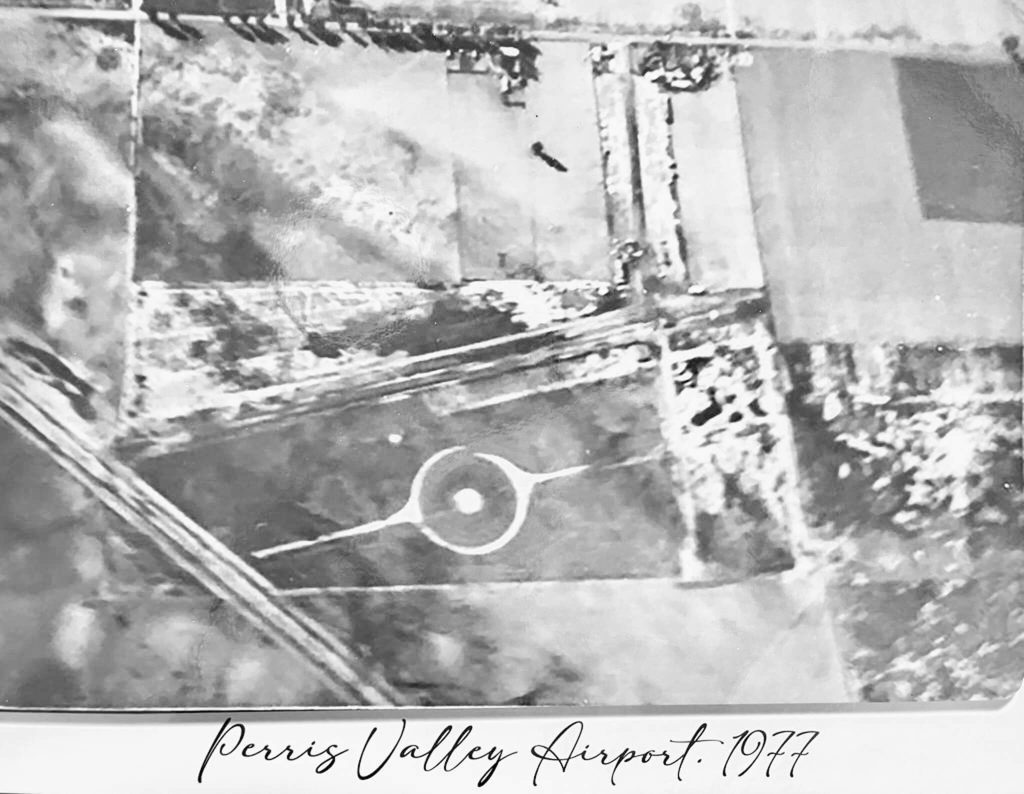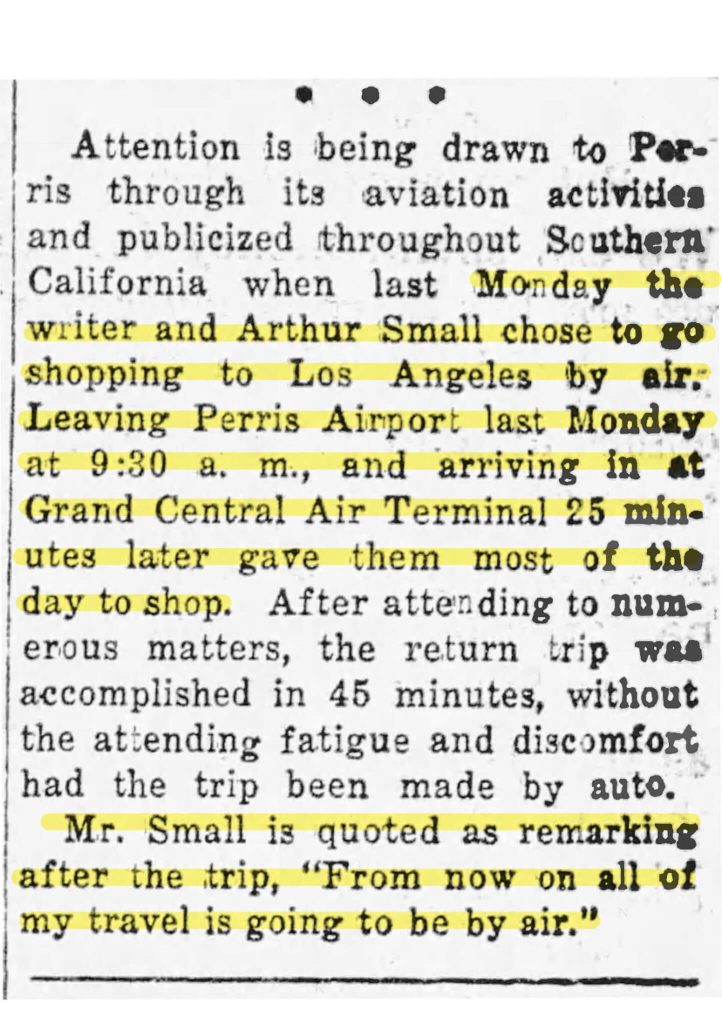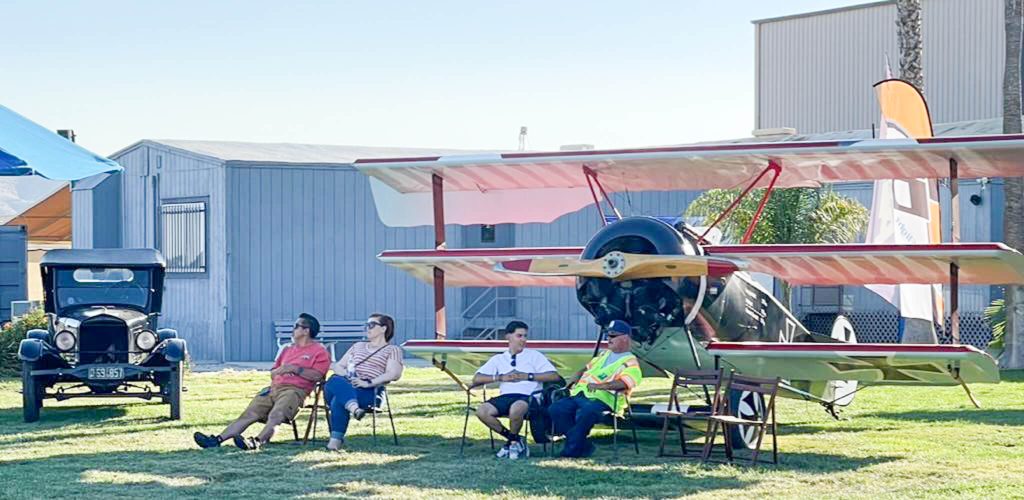Perris Valley Airstrip
By Don Ray
An airport’s 90th birthday party? How the heck could that happen?
It all started when the Perris Valley Historical Museum’s Director, Katie Keyes, was pouring through eBay offerings looking for anything that might have a connection with Perris and its environs.
Bingo.
Keyes pounced on a “special dedication” envelope prepared by the Perris Chamber of Commerce about the October 8, 1933, grand opening of what would become known as the Perris Valley Airport.
She’d been friends for decades with the airport’s subsequent owners, Ben and Diane Conatser and their children; Patrick and Melanie, who now run the airport and its world famous Skydive Perris.
“So, I gave it to them,” Keyes said.
Patrick (Pat) Conatser thought it was amazing.
“So, I did a little research,” he said, “and, come to find out, that the airport, early on, was basically an airfield — like they all were in the day — a big, dirt strip. At some point, it had a couple of cross dirt runways.

In covering the event in 1933, The Perris Progress headline reported, “Enthusiastic Crowd at Opening of Airport,” informing readers that a highlight was, “…an acrobatic exhibition flight by Bill Duden, (the airport manager) and the arrival of “Cowboy” Roman Warren of Riverside airport in his Great Lakes biplane.”
A decade later, “during World War II, it was used for glider training when they were getting ready for the D-Day Invasion,” Conatser said.

It also became an alternate area for glider pilots to land, he says, if they couldn’t make it all the way to March Airfield.
With the 90th anniversary of that “grand opening” approaching, Conatser decided to team up with today’s Greater Perris Valley Chamber of Commerce and throw an airport’s 90th birthday bash last Sunday, October 8, 2023, ninety years to the day after the opening.
“We’re excited to be here and celebrate their 90th birthday,” the chamber’s president Jerry Sepulveda said. “The Chamber has been here since 1912.”
Sepulveda said that when Pat Conatser told him that his chamber had dedicated the grand opening, they were all eager to participate.

The open-to-the-public birthday party featured free slices of birthday cake, a weekend-long D.J., an antique car show on the runway, skydiving demonstrations, and a discounted, outdoor food buffet. They also offered discounts on items for sale at the skydivers’ boutique.
And for the more adventurous birthday guests, Skydive Perris offered discounts on tandem jumps as well as discounts on their indoor jump simulator.

Conatser’s research of the airport property filled in the gaps between its grand opening in 1933 and 1976 when his parents acquired it.
“After the war,” he said, “it was a small, agricultural-type airport. The city of Perris probably used it for mail and that kind of stuff.
In 1962, Conatser says, some former military guys created a parachutists’ drop zone, where one of them made the first jump. A couple of families owned it then, he said, and flew mostly small, single-engine Cessna-type aircraft there and some crop dusters.
“In about 1976, my dad and mom were looking for an airport to build houses on,” Conatser said, “and have your own, fly-in community, so you could pull up to your house in your airplane and park it in the garage.”

Not a completely crazy plan.
A month after the airport’s opening, the November 16, 1933, edition of The Progress, reported the airport was all the local rage.
In a 1st person account, the writer was accompanied by Arthur Small, on a shopping trip to Los Angeles. By plane. Landing at the historic Grand Central Air terminal in Glendale.
After a day of hitting the holiday sales, and the 45-minute flight back to Perris, Mr. Small is reported to have exclaimed, “From now on all of my travel is going to be by air.”
So, four decades later, the concept of a fly-in housing development wasn’t that off-the-wall. Pretty practical, actually.
But the Perris Planning Department wasn’t taking flight with the idea, deciding it may end up under water.
The airport is in a flood plain.
So, what were the Conatser’s to do?
As son Pat now explains of his father, “he’s got this drop zone and there were some skydivers, but he didn’t have a plane.”

His parents needed a way to pay the bills, he says, so they bought a plane and started serving the local skydivers.
“One thing led to another,” Conatser says, “and basically, we built that into the world’s largest parachute center.”
Today, he said, Skydive Perris does 130,000 jumps a year and trains parachutists from all over the world — many of them military members sponsored by their governments.

Ninety years ago, Boeing introduced a revolutionary all-metal airplane, featuring cantilevered wings, auto pilot and ‘sort of’ retractable landing gear. The Boeing 247 was faster than the premier fighter plane of the day, able to cross the U.S. from San Francisco to New York in a mere 19 ½ hours, with a few stops to refuel along the way. It cruised on a single engine at an altitude of 11,500 feet.
In 2016, at the time, the world’s oldest flyable Boeing airliner, the twin-engine 247D was retired after a 26 nautical mile flight from the Museum of Flight’s Restoration Center at Paine Field in Everett, WA to the Museum’s Boeing Field at King County International Airport in Seattle.

At the controls, was the original chief test pilot for Boeing’s newest, largest jet, the 787 Dreamliner. The 787, with 300 or so passengers on board, is capable of cruising from San Francisco to New York, back to San Francisco and then back to New York again without having to fill ‘er up. And in considerably less than 19 ½ hours.
Aviation has changed a bit in 90 years.
Though the scale is much different than Boeing’s, in the same 90 years, the Perris Valley Airport has transcended from a dirt strip to a vital D-Day training ground, to an unrealized vision for an aviation residential community, to a world-wide destination.
One where men and women convene to jump out of perfectly good airplanes, holding hands.
Kumbaya and Happy Birthday.
For More Perris News Visit www.zapinin.com/perris.


